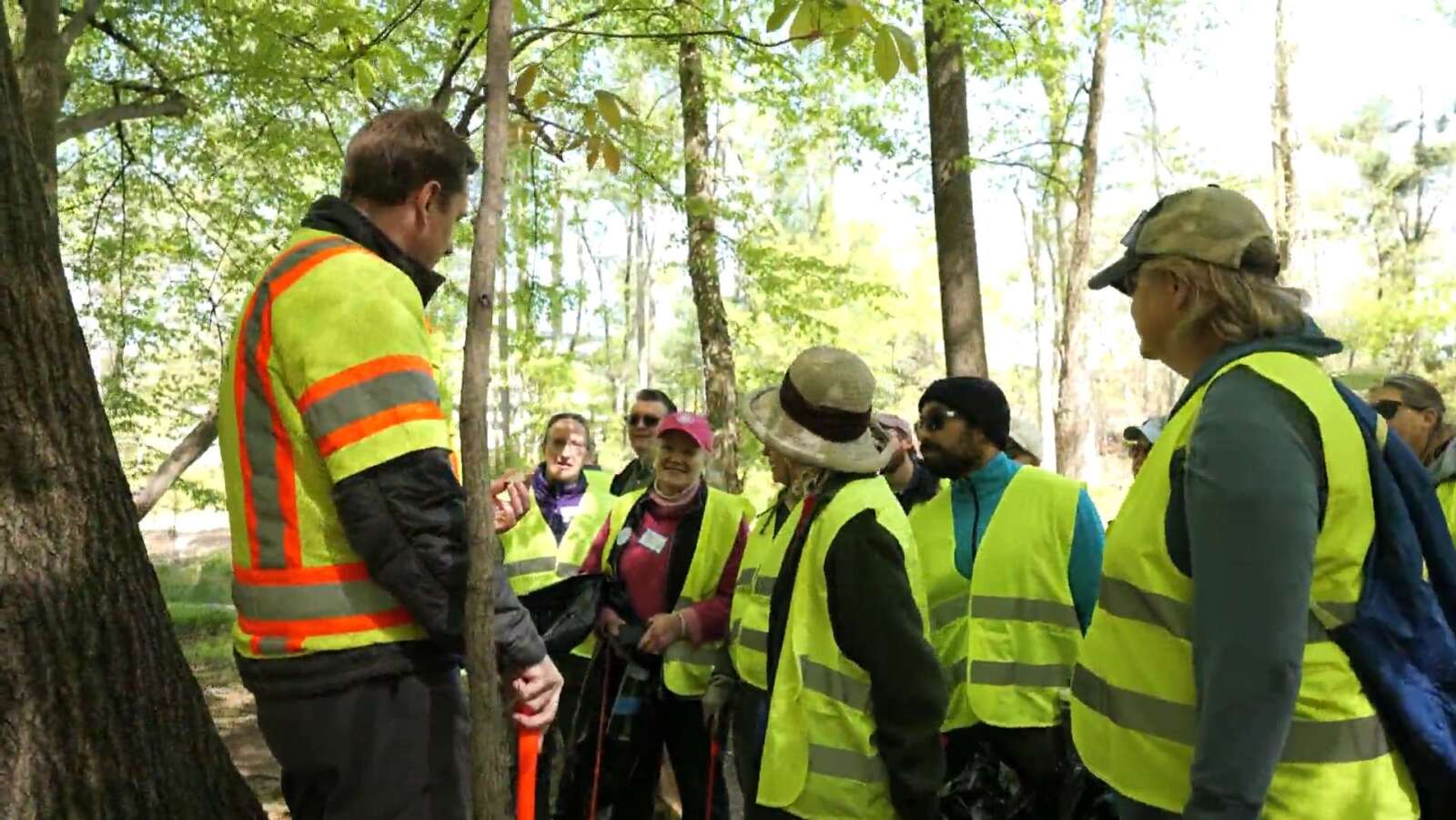
The continued development of Tysons doesn’t have to come at the expense of its remaining natural green space, argues a recent report on ways to preserve 65 acres of forest in the urban center.
A community task force has recommended two dozen actions that could help preserve and even enhance wooded areas collectively known as Tysons Forest, including tree plantings and clean-up efforts. Dated March 24, the report was formally accepted by the Fairfax County Board of Supervisors on April 16.
“Usually, task forces are not looking at preserving natural areas like this and enhancing them, but it was a really wonderful and very positive community-led effort,” Hunter Mill District Supervisor Walter Alcorn said at the board meeting.
Alcorn assembled the Tysons Forest Community Task Force last September to craft a plan for protecting the woods along Tysons’ southwestern edge. Spanning the Dulles Toll Road to Gosnell Road, the expanse includes the 33-acre Old Courthouse Spring Branch Stream Valley, the Ash Grove Historic Site and Raglan Road and Freedom Hill parks.
Chaired by resident Jack Russell, the task force counted residents, local building owners, office tenants, Fairfax County Park Authority staff and other county representatives, and conservation experts among its 23 members.
After meeting throughout the fall and winter, the group solidified recommendations that it hopes will enable humans and wildlife to coexist, while making Tysons Forest “sustainable and emerald green forever.”
Leading the proposals is the need for the county to officially recognize the stream valley corridor as Tysons Forest, including by adding wayfinding signage, and incorporate a pledge to protect the habitat in its Tysons Comprehensive Plan.
The task force also highlighted the importance of replenishing the area’s tree canopy, which it reported has declined by approximately 20-25% in the past five years. In addition to planting 200 wire-guarded trees and seedlings annually, the report suggests cutting down on the amount of invasive plants by at least 50% by 2028 and conducting counts of birds, bees and other wildlife to measure the area’s biodiversity.
Other notable recommendations include:
- Revive the Ashgrove Trail extension project and evaluate options for connecting it to the Vesper Trail south of Spring Hill Road
- Expand Tysons Forest by securing proffer contributions from developers and encouraging property owners to adopt ecologically friendly practices
- Maintain a safe and clean forest by requiring developers to mitigate run-off into streams, adding trash cans along walking trails and conducting regular trash cleanups
- Enlist local students as “green champions” by offering volunteer opportunities and including youth on future task force teams
- Create a website and events calendar for Tysons Forest
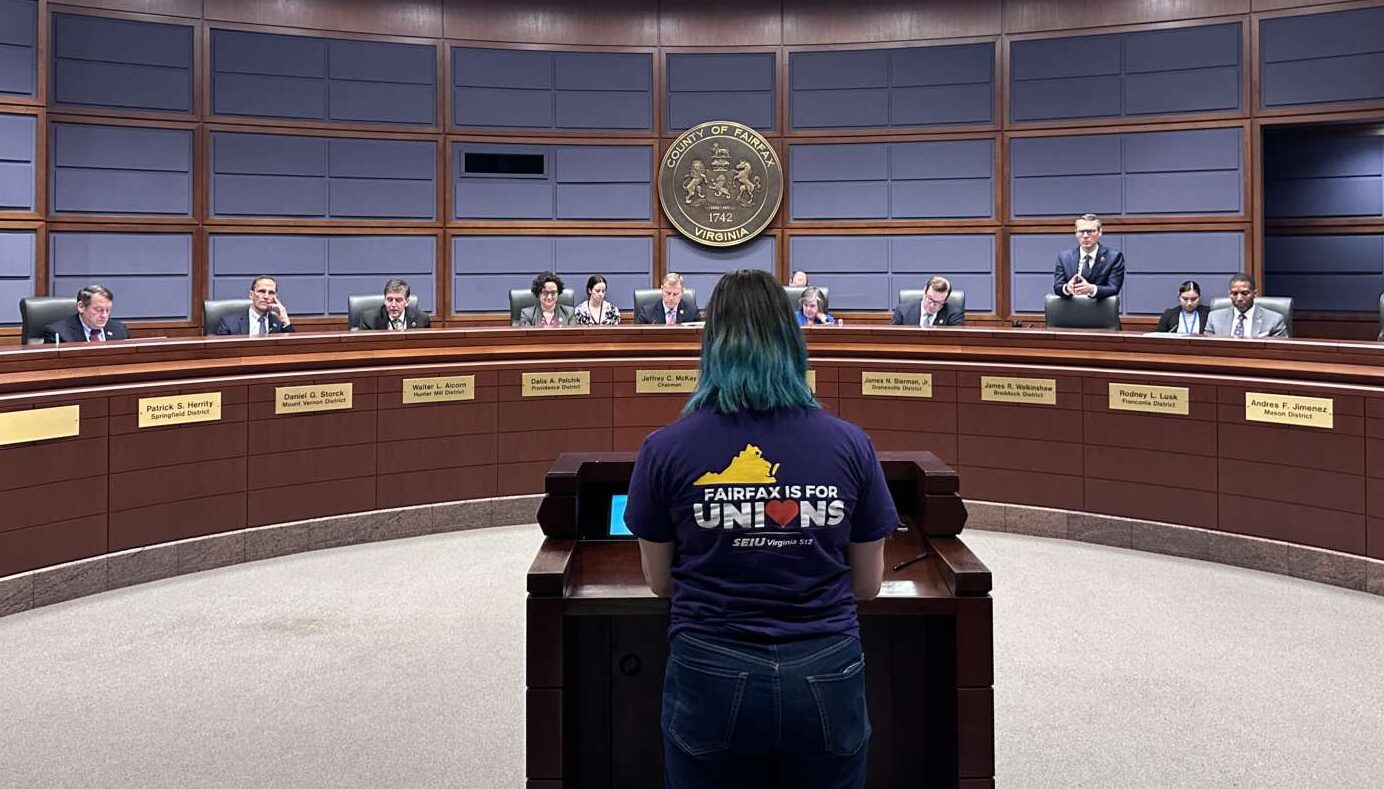
The Fairfax County Board of Supervisors faces tough decisions ahead of next week’s budget markup session, following demands from local unions to increase county employees’ wages.
Last week, dozens of county employees from various departments gathered at a series of public hearings to protest the 2% market rate adjustment (MRA) included in the county executive’s proposed fiscal year 2025 budget — asking instead for an increase of at least 4%.
Every year, the county compares its salaries against similar jobs in the area to ensure pay is competitive. Though the full market rate adjustment was estimated at over 4%, County Executive Bryan Hill proposed allocating roughly $24 million for a 2% increase for FY 2025, citing revenue constraints.
Many county employees who attended the April 16-18 public hearings on the advertised budget, which will take effect on July 1, argued that wouldn’t be enough to keep up with the cost of living.
Lauren Tumbleson, a social services worker and member of SEIU Virginia 512, a union for general county employees, said she is considering leaving her job to care for her 4-year-old son, as child care costs would be too high without a bigger pay raise.
“Not fully funding the MRA this year will have a direct impact on our daily lives,” she said during the April 17 hearing.
Other SEIU members and representatives from the Fairfax Workers Coalition (FWC) said that without the pay raises, departments will continue to experience staff turnover, reducing the quality of services to residents.
FWC member Marie Kenealy, a veteran parole officer at the Juvenile and Domestic Relations District Court, noted that inadequate staffing and training puts at risk both the safety of the staff and their ability to help youth in the judicial system.
“We are part of the courts, but we do not have the protections afforded to law enforcement,” she said on April 17. “…At times, we escort violent offenders without adequate protection or training. At times, we are confronted with gang violence, aggression, exposed to fentanyl, and we’re often conducting home visits where we know firearms are likely present.”
Without fair wages and improved conditions, the court risks losing experienced personnel, Kenealy said.
Many local educators called on the Board of Supervisors to fully fund Fairfax County Public Schools Superintendent Michelle Reid’s $3.8 billion budget request — including an additional $254 million to adequately compensate the public education system’s employees.
Jennifer Ives, a special education teacher at James Madison High School in Vienna, said she knows several experienced colleagues who have left to take higher paying jobs in surrounding counties.
Ives argued that funding the superintendent’s request could mean less staff turnover, because teachers may be able to afford to live closer to where they work.
“The increase could help us find one of the cheaper rentals in the area and maybe I could have a 30-minute commute instead of an hour and a half,” Ives said. “I’d be able to sleep in past 5 a.m. and maybe get home an hour before dinner.”
When Hill presented his budget proposal in February, supervisors lamented that the burden of funding FCPS falls too heavily on the county due to limited funding from Virginia.
Earlier this month, Governor Glenn Youngkin proposed budget amendments that, according to WTOP, would reduce funding for FCPS by nearly $17 million for FY 2025 and $24 million in fiscal year 2026.
Regardless of the state budget, though, Fairfax County School Board Chair Karl Frisch argued the county needs to ensure the school system can pay its employees competitive wages at a time when enrollment and demand for services is increasing countywide.
“Our budget request does not include new initiatives,” Frisch said during the board’s April 16 hearing. “We are focusing on what is needed to continue ensuring excellence in our schools.”

The Fairfax County Board of Supervisors is asking the county’s General Assembly delegation to oppose Gov. Glenn Youngkin’s proposed funding cuts to Metro in the state’s budget.
During a board meeting on Tuesday (April 16), supervisors unanimously approved a letter written by Chairman Jeff McKay, Braddock District Supervisor James Walkinshaw, and Dranesville District Supervisor James Bierman, asking the delegation to oppose the cuts and retain the funding needed to address the Washington Metropolitan Area Transit Authority’s (WMATA) estimated $750 million shortfall.
The General Assembly passed the FY 2024-2026 biennium budget in March which included $149.5 million from the state to address WMATA’s funding shortage in FY 2025 and FY 2026, according to the letter.
“This funding, which is expected to be matched by the local funding partners, including Fairfax County, is essential to putting WMATA on sound financial footing and retaining its consistent operations.”
A month later, Youngkin announced his proposed budget amendments, which included cutting $113.8 million of WMATA’s funding. Instead, Youngkin urged localities to use funds previously allocated to them through state assistance.
However, the county clarified in its letter that this money — provided to the region through the Northern Virginia Transportation Commission (NVTC) by the Northam Administration in 2022 — was used to cover immediate Metro payments following the pandemic and to reserve the remainder for “ongoing needs.”
Even with the additional funding, the letter says the county expects the money from the NVTC to be largely depleted soon, making their request even more vital.
“We know WMATA is absolutely essential to our regional economy,” McKay said during Tuesday’s County Board meeting. “It is essential to Virginia’s economy, bringing in over $1 billion a year into the general fund.”
He also noted how the lack of funding could impact taxpayers.
“If this money doesn’t come from the state, where will it come from? From the real estate taxpayers of Fairfax County. That’s where it will come from,” McKay said.
Springfield District Supervisor Pat Herrity said he was reluctantly supporting the request, saying Metro needed to “figure out how they’re going to get their costs under control.”
“We’ve got to get the long-term answer figured out because, you know, punting it down the road with a couple more years of ridiculous funding increases is not necessarily the best answer,” Herrity said.
Citing a 2017 study by former U.S. Department of Transportation Secretary Ray LaHood, Walkinshaw noted that Metro would need $500 million a year in dedicated funding to achieve stable financial footing, a burden that would ultimately fall on resident taxpayers.
“This idea that there are hundreds of millions of dollars or billions of dollars of cost savings to be found at Metro is a fantasy,” he said. “The amount needed in dedicated funding to prevent us from having to go back to property taxpayers every single year is in the hundreds of millions of dollars. That’s just math.”
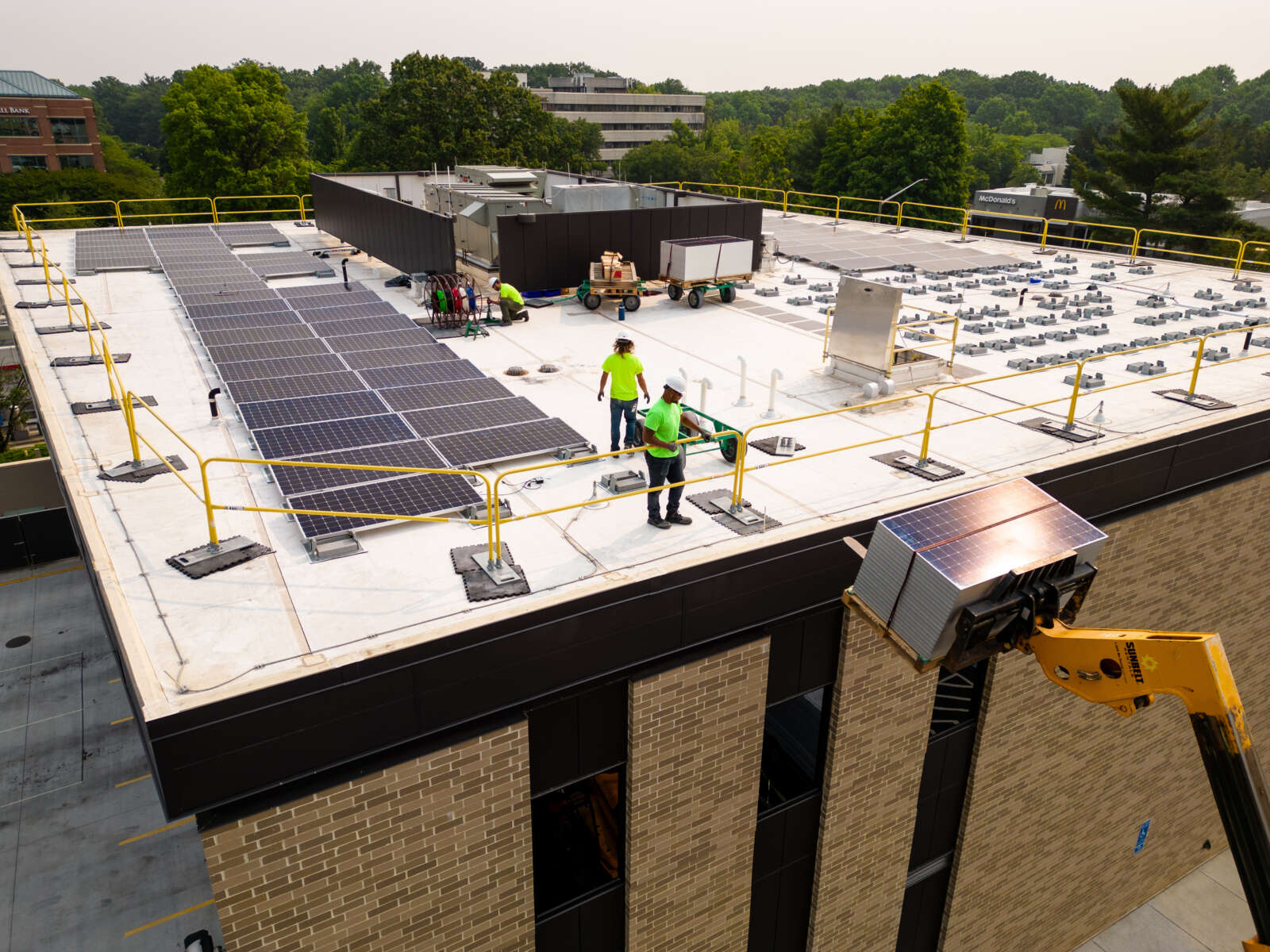
Fearing that new interconnection rules from Dominion Energy could derail its carbon reduction targets, the Fairfax County Board of Supervisors has asked Virginia’s utility regulator to step in.
In a near-unanimous vote, supervisors authorized Braddock District Supervisor James Walkinshaw on March 19 to send a letter asking the State Corporation Commission (SCC) to evaluate whether the new regulations create unnecessary hurdles for small renewable energy projects attempting to join the power grid.
Springfield District Supervisor Pat Herrity was the only abstention.
Dominion maintains that the new regulations are necessary to ensure grid reliability and the safety of field workers, but Fairfax County and other stakeholders statewide remain skeptical, contending that they make renewable energy projects more expensive and less feasible.
“In the Hunter Mill District, I have an elementary school [project] that has been complicated by this requirement,” Hunter Mill District Supervisor Walter Alcorn said. “It’s gonna be coming to the Board of Supervisors here the next couple of months, but this is creating a real impediment to doing what we need to do.”
Cost added for dark fiber lines
Dominion says it updated its interconnection requirements in response to the 2020 Virginia Clean Economy Act, which increased the capacity limit for non-residential solar developments from 1 to 3 megawatts (MW).
As a result, Virginia experienced a surge in solar, wind and other renewable energy installations that generate over 1 megawatt looking to connect to the power grid. To accommodate more and bigger energy sources, Dominion began requiring smaller energy projects from 250 kilowatts (kW) to 3 MW to install a high-speed fiber optic communication line — known as “dark fiber” or “direct trip transfer” (DTT) — between the project site and the nearest substation in 2022.
Dominion spokesperson Aaron Ruby says dark fiber is “more reliable” than cellular communication, which is prone to receiving mixed or missed signals. This could lead to unnecessary power outages if a solar facility’s power is mistakenly cut off due to a weak signal.
In addition, if there’s an emergency, dark fiber can more reliably signal the power source to turn off, ensuring line workers can fix the problem safely.
“So, this is not an issue of being ‘pro-solar’ or ‘anti-solar,'” Ruby said by email. “It’s simply about having the same basic safety and reliability standards for all solar systems that connect to the grid. The standards for medium-sized systems (i.e., 250 kW-3MW) are the same standards that apply to all of our solar facilities. These standards ensure the reliable operation of the grid and the safety of our line workers when they’re out in the field.”
Ruby noted that Dominion has one of the largest solar fleets in the country, and solar will be “by far the largest source of new power generation in Virginia over the coming decades.”
Yet, Fairfax County officials argue that no other utilities in the region place the entire cost burden of installing dark fiber lines on developers.
“Our staff has gone and looked — we couldn’t find any other utilities in the region that require this level of cost and expense,” Walkinshaw said during the board’s March 19 meeting. “So, are they necessary? Other utilities have determined that they aren’t, and as to who bears the cost, given that there are benefits both to the new interconnection and the owner of that interconnection and everyone else who utilizes the grid…we would not accept that they are all necessary.” Read More
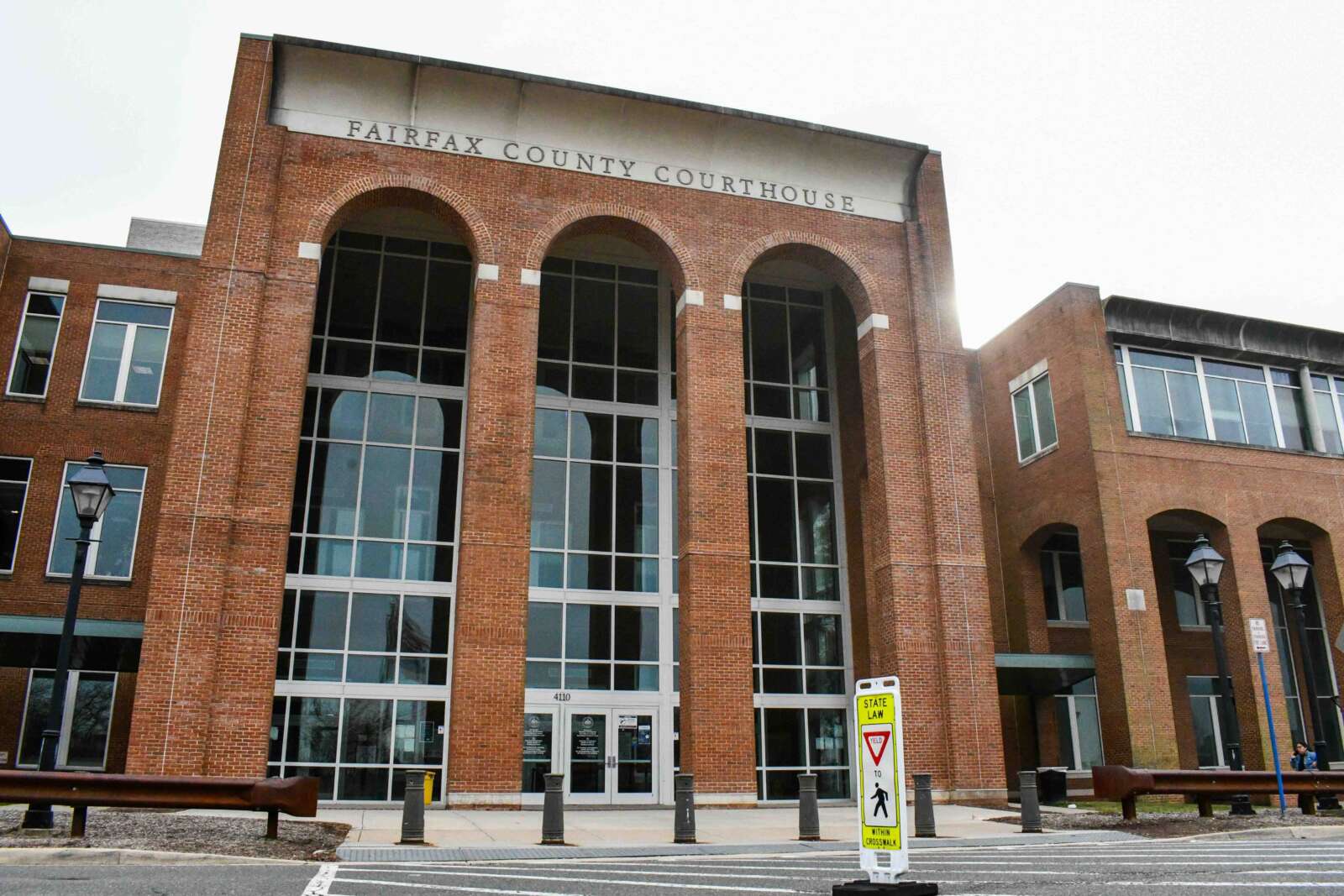
The Fairfax County Board of Supervisors is considering using kiosks equipped with artificial intelligence to provide select legal information in a variety of languages.
The kiosks would feature a virtual assistant that could answer frequently asked questions using a closed-AI system (as distinct from open AI), according to Franconia District Supervisor Rodney Lusk, who introduced a board matter on the kiosks at the board’s March 19 meeting.
“The distinction is that we will program the answers to frequently asked questions into the system using curated templates and language,” Lusk told FFXnow. “The AI program will not be creating its own answers.”
None of the questions are finalized yet, but they could help users identify forms and address other process-related queries. The virtual assistant would also be available online, and both resources would have accessibility features.
County and court staff are reviewing the kiosks and online AI program, and the board voted on March 19 to direct staff to finalize its review and report back. The county also plans to reach out to relevant nonprofits to assist in testing the kiosks, Board of Supervisors Chairman Jeff McKay said at the meeting.
The kiosks and online resource would be an “extension” of the self-help resource center that the county rolled out in October, according to Lusk’s board matter. Staff at the resource center can explain court operations, provide contact information for legal services and answer some general questions.
The resource center launched to assist county residents who are representing themselves in court. The new resources could help residents who aren’t able to travel to the center, which is located in the Fairfax County Courthouse (4110 Chain Bridge Road), though no kiosk locations have been selected.
“Personally, I feel it could be beneficial to be placed in government facilities that are remote from the Fairfax County Government Center and the Fairfax County Courthouse,” Lusk said by email, citing the Gerry Highland Government Center (8350 Richmond Highway) or Franconia Governmental Center (6121 Franconia Road) as examples. “We know that people live great distances from the Government Center and Courthouse, which limits the accessibility of these services.”
The board matter passed unanimously, despite a public meeting notice issue that McKay said left some board members without the opportunity to see the kiosks. Providence District Supervisor Dalia Palchik also said she was concerned about making sure the kiosks were fully vetted before they’re implemented.
The topic will come to the board’s health and human services committee for additional discussion, though the board didn’t specify a date. The committee’s next meeting is currently scheduled for June 4.
Testing the kiosk with actual users and not rushing the process will be important, McKay said, adding that the county should also plan to reach out to the state about support for the program.
“What we don’t want to do is just rush in and further complicate and frustrate people where there’s a misinterpretation and they’re getting the wrong documents that they need to help their case,” McKay said.
Eighty new affordable homes for seniors have become available just east of George Mason University.
Located at 10055 Braddock Road, Ilda’s Overlook Senior Residences serves individuals aged 62 and over with incomes at or below 60% of the area median, developer Arlington Partnership for Affordable Housing (APAH) said in a press release.
Erickson Senior Living chose APAH as its affordable housing partner in 2019 for the redevelopment of the former Northern Virginia Training Center, which closed in 2016.
The developers broke ground on the $31.5 million development in late 2022. The development was primarily funded through Low-Income Housing Tax Credits awarded by Virginia Housing, along with loans from various other public and private entities.
The completion of Ida’s Overlook furthers Fairfax County’s progress toward its goal of adding 10,000 affordable homes by 2034. Earlier this month, officials announced that approximately 4,000 affordable homes have been built, are in the planning stages, or are currently under construction.
“The delivery of Ilda’s Overlook puts us at almost 1,000 new, affordable homes delivered since January of 2020,” Board of Supervisors Chairman Jeff McKay said in the release. “By the end of the calendar year, we will be close to 1,500 new homes. This is great progress and demonstrates that affordable housing belongs in all corners of Fairfax County, and across all generations.”
The new apartment complex’s name — Ilda’s Overlook — pays homage to a community established by two formerly enslaved blacksmiths, Moses Parker and Horace Gibson. After the Civil War, Gibson bought 5 acres of land near Guinea Road and the Little River Turnpike that developed into a vibrant, integrated neighborhood.
The community took on the name of Gibson’s daughter Matilda, who was nicknamed Ilda, according to APAH.
“One of APAH’s core values is racial equity, and we lead with this lens. It’s exciting to honor local history while we build for the future and strive for a more inclusive region,” APAH President and CEO Carmen Romero said in the release. “Ilda’s Overlook is thoughtfully designed for independent seniors to age in place, foster social connections, and build a sense of community.”
Ilda’s Overlook features a range of amenities, including in-unit washers and dryers, free Wi-Fi access for all residents, communal gathering areas, a fitness studio, wellness suites and community gardens. Additionally, the development is equipped with rooftop solar panels.
“Ilda’s Overlook Senior Residences provides much needed affordable housing for older
adults in the Braddock District,” Braddock District Supervisor James Walkinshaw said in the release. “This beautiful property is one of many recently opened or under development across the County — all with the goal of improving the availability of high-quality affordable housing to older adults.”

Fairfax County’s next budget could give its public libraries a little more spending money for books.
At the Board of Supervisors meeting on Tuesday (March 19), Hunter Mill District Supervisor Walter Alcorn proposed allocating an additional $500,000 in the upcoming fiscal year 2025 budget to Fairfax County Public Library’s book collection.
“The Library continues to be one of the most popular services provided by the county and our Library branches are a vital hub of community information,” Alcorn said in his board matter. “…We continue to face issues with meeting the demand for library materials even with the digital formats.”
County Executive Bryan Hill presented a proposed budget on Feb. 20 that increases FCPL’s funding by $410,027, partially offsetting a $1.2 million jump in personnel-related costs with cuts to the system’s operating expenses.
Planned reductions include eliminating a vacant management position, shifting to black-and-white public copiers instead of color ones, adjustments to the number of computers at each branch based on usage, taking over data storage from a third-party vendor and making FCPL’s quarterly magazine digital-only.
Overall, the county is budgeting just under $35 million in expenditures for the library system, most of which ($22 million) goes toward day-to-day operations at its 23 branches.
Alcorn noted that the county’s funding is supplemented by contributions from the nonprofit Fairfax Library Foundation and the Friends groups that support individual branches. The Friends of Reston Regional Library, for instance, donated $100,000 earlier this year to boost the children’s books collection county-wide.
However, funding for books and other materials remains inadequate “to meet the needs of our residents,” who sometimes have to wait months or even more than a year for popular items, he said.
With increased demand for popular and new materials, the Library must balance a proper allocation of limited resources for those items with the needs for materials in support of K-12 students, and ensuring that materials are updated, available in print, large print, audio and digital copies and in multiple languages. Additional funds to the collection budget will ensure that we are providing the resources our community demands from our Library and decrease the wait times so that people can access those resources in a timely fashion.
The Board of Supervisors agreed unanimously on Tuesday to add Alcorn’s proposal to its list of items to consider incorporating into the budget, which includes $3.83 million in not-yet-allocated funds.
Springfield District Supervisor Pat Herrity also asked county staff to find out why FCPL is only devoting about 10% of its budget to purchasing materials and whether that guidance comes from the county, the library’s Board of Trustees or the state.
“I think we do need to clearly invest in our library collections,” Herrity said. “It’s something our citizens like. It’s a basic public service we need to promote.”
Town hall meetings on the proposed budget are currently underway, with the Franconia District holding the next one at 6 p.m. today (Friday). Public hearings are scheduled for April 16-18, and the board will mark up the budget, including determining whether to add items like the library funding, on April 30.
A final FY 2025 budget will be adopted on May 7.

Students are getting organized in response to a lawsuit challenging Fairfax County Public Schools for its LGBTQ-inclusive policies.
The Pride Liberation Project, a student-run group that advocates for LGBTQ+ rights in Virginia, will host a rally “against anti-trans hate” outside Luther Jackson Middle School in Merrifield at 6 p.m. today (Thursday). The demonstration will precede the Fairfax County School Board’s meeting, which starts at 7 p.m.
“I’m really hoping that Fairfax County and our school board will stop this attempt to hurt and degrade my fellow students,” Laura Troung, a senior at Falls Church High School, said. “LGBTQIA+ students are already disproportionately facing the youth mental health crisis in addition to bullying and harassment at schools and this is just adding salt into the wound.”
Represented by America First Legal, a right-wing legal group led by former Donald Trump advisor Stephen Miller, an unnamed high school student sued the school board on March 4 over its policies dictating that students be treated in accordance with their gender identity.
In her complaint, the student says being “compelled” to address classmates by the name and pronoun that matches their gender identity violates her religious beliefs as a Roman Catholic. She also argues that the policies discriminate on the basis of sex because of her discomfort with using the same bathroom as transgender girls.
Students with the Pride Liberation Project, however, describe FCPS’ regulation 2603 as critical to creating a safe, welcoming environment for LGBTQ+ individuals.
Transgender youth whose peers affirmed their identities, including by using their correct names and pronouns, reported significant reductions in symptoms of severe depression, suicidal thoughts and suicide attempts in a 2018 study conducted by University of Texas at Austin researchers.
In contrast, reported school-based hate crimes targeting LGBTQ people have soared since 2015, particularly in states with laws that restrict the rights of transgender students or prohibit education on gender and sexuality, according to the Washington Post.
The Virginia Department of Education’s model policies directing schools to treat students based on their “biological sex” spurred protests and school walkouts across the state in September 2022, including ones organized by the Pride Liberation Project.
Students also rallied outside Luther Jackson Middle School last year after FCPS pledged not to adopt the state policies.
“The fact that so many of my friends and teachers respect my pronouns and my name is life-saving to me,” Moth DiNizzo, a McLean High School junior, said. “I know that they care about me and trust my own self-perception. It’s wonderful and I want everyone to experience that same joy of being known and trusted.”
The planned rally comes shortly after the Fairfax County Board of Supervisors designated March 31 as Transgender Visibility Day. The International Transgender Day for Visibility was created in 2009 to celebrate the lives and achievements of the transgender community.
At its meeting on Tuesday (March 19), the board approved the proclamation 9-0 with Springfield District Supervisor Pat Herrity, the board’s only Republican member, away from the table.
Supervisors said the designation is an important acknowledgement of the county’s diversity and their commitment as elected officials to support all residents.
“We have an obligation to do everything we can not just to protect [the LGBTQ+ community], but to use our voices to stand up and support them and to make sure that the rest of our community sees that that’s what their government is doing,” Chairman Jeff McKay said. “Regardless of what’s happening in Richmond, we will always stand up and fight to protect every single person in this county.”
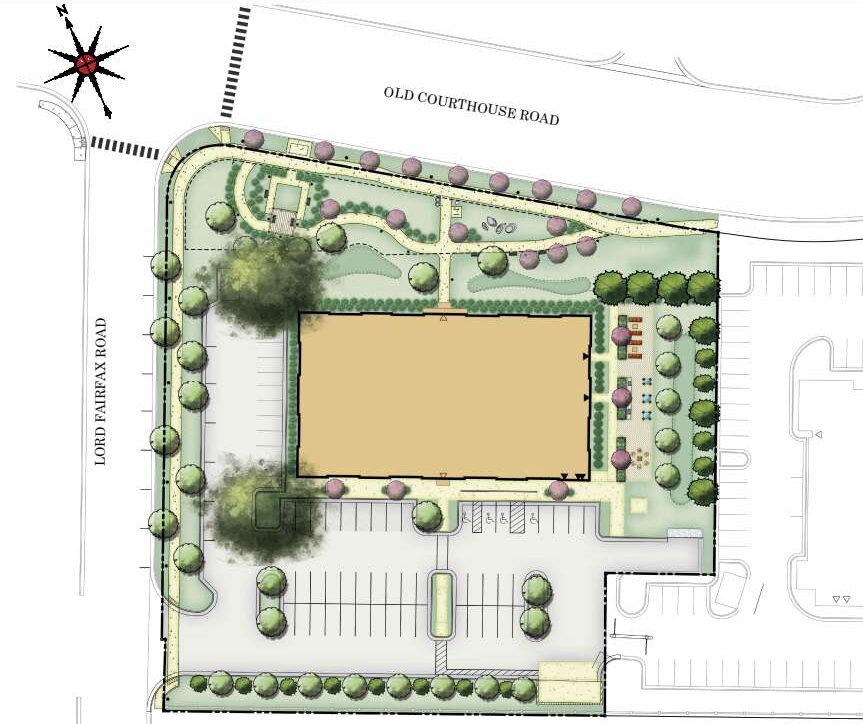
Another Tysons office building is set to be transformed into housing.
After a public hearing on Tuesday (March 19), the Fairfax County Board of Supervisors approved a proposal to convert the three-story office building at 8221 Old Courthouse Road into 55 multi-family apartments, including six workforce dwelling units.
About 70% of the apartments will have one bedroom, but some two-bedroom units will also be provided, according to Walsh Colucci Lubeley & Walsh land use attorney Robert Brant, who represented the property owner and developer, a Dittmar Company affiliate, at the hearing.
While the existing 45,000-square-foot building will stay intact, the development will bring pedestrian and streetscape improvements to Old Courthouse and Lord Fairfax roads, including new sidewalks, landscaping and crosswalks at the intersection.
The plan replaces about 90 parking spaces with open space, including a publicly accessible, 7,840-square-foot pocket park and a private, 8,400-square-foot outdoor space for residents. Amenities available to the public will include 6-foot-wide walkways, pergolas, benches and bicycle racks, while the private space will provide movable seating, tables, grill stations and stormwater facilities, such as a rain garden.
“We were very focused on the green space, and I believe the homeowners or renters would want that as well,” Providence District Supervisor Dalia Palchik said of the county’s negotiations with the developer.
However, the trade-off of parking spots for green space has left some area residents concerned that traffic for the new apartments will spill into their neighborhoods and disrupt travel to and from nearby Freedom Hill Elementary School.
Dittmar agreed to retain 66 spaces in the existing parking lot and add striping for eight spaces on Lord Fairfax Road, meeting the county’s minimum requirement.
One homeowner’s association sent a letter to the board on Feb. 21 worrying that the apartment residents will compete for parking currently used by parents when dropping off and picking up their kids, Board of Supervisors Chairman Jeff McKay said.
At the public hearing, one resident whose daughter walks to Freedom Hill said she’s concerned about increased traffic and safety at the Old Courthouse/Lord Fairfax intersection. Claudia Stein, who lives on Lord Fairfax Road across from the site, urged the developer to keep at least 30 more parking spaces.
“There is always more demand for parking than anticipated,” Stein said. “The apartment residents and guests will be forced to park on the street in the neighborhood, which will take away parking from existing residents.”
Residents have also been advocating for the county to close a gap in the sidewalk on the west side of Lord Fairfax Road, Stein said. As a temporary measure, the gap has been filled with gravel, but vehicles sometimes park on the gravel, forcing students and other pedestrians into the road.
After confirming the location of the sidewalk gap, supervisors said they can’t compel the developer to address it, since it’s not on their property. Providence District Supervisor Dalia Palchik confirmed that her office will work with Stein to see what can be done by the county.
“It just seems like a great opportunity for our [department of transportation] to work with the property owner to maybe make an improvement in the future,” McKay said.
In response to the concerns about traffic, Brant told the board that shifting the property from office to housing will reduce parking demand and vehicle trips, which are projected to drop by 75% during the morning rush hour and 77% in the evening rush hour.
For some supervisors, the big sticking point was the developer’s commitment to only meeting the county’s minimum — 2% of parking spaces — for electric vehicle charging stations. That amounts to just two of the 66 provided spaces.
“I literally got sent an article yesterday about how electric vehicles and gas-powered cars are starting to level out in cost,” Dranesville District Supervisor Jimmy Bierman said. “If you want this building to be good for residents 10 years down the line, you’re going to need more than 1.32 spaces, so please provide more.”
McKay suggested that the developer consider pre-wiring some spaces so they can support EV chargers “in the future if the demand is there.”
Dittmar is “willing” to look at providing more EV charging stations, Brant said.
“We’ve had discussions internally about how more and more electric vehicles are on the road these days,” Brant told the board. “More residents want that as an amenity, so there’s a chance that, once we get into the construction phase of this, there will be an opportunity to add more. So, that’s something the applicant will consider.”
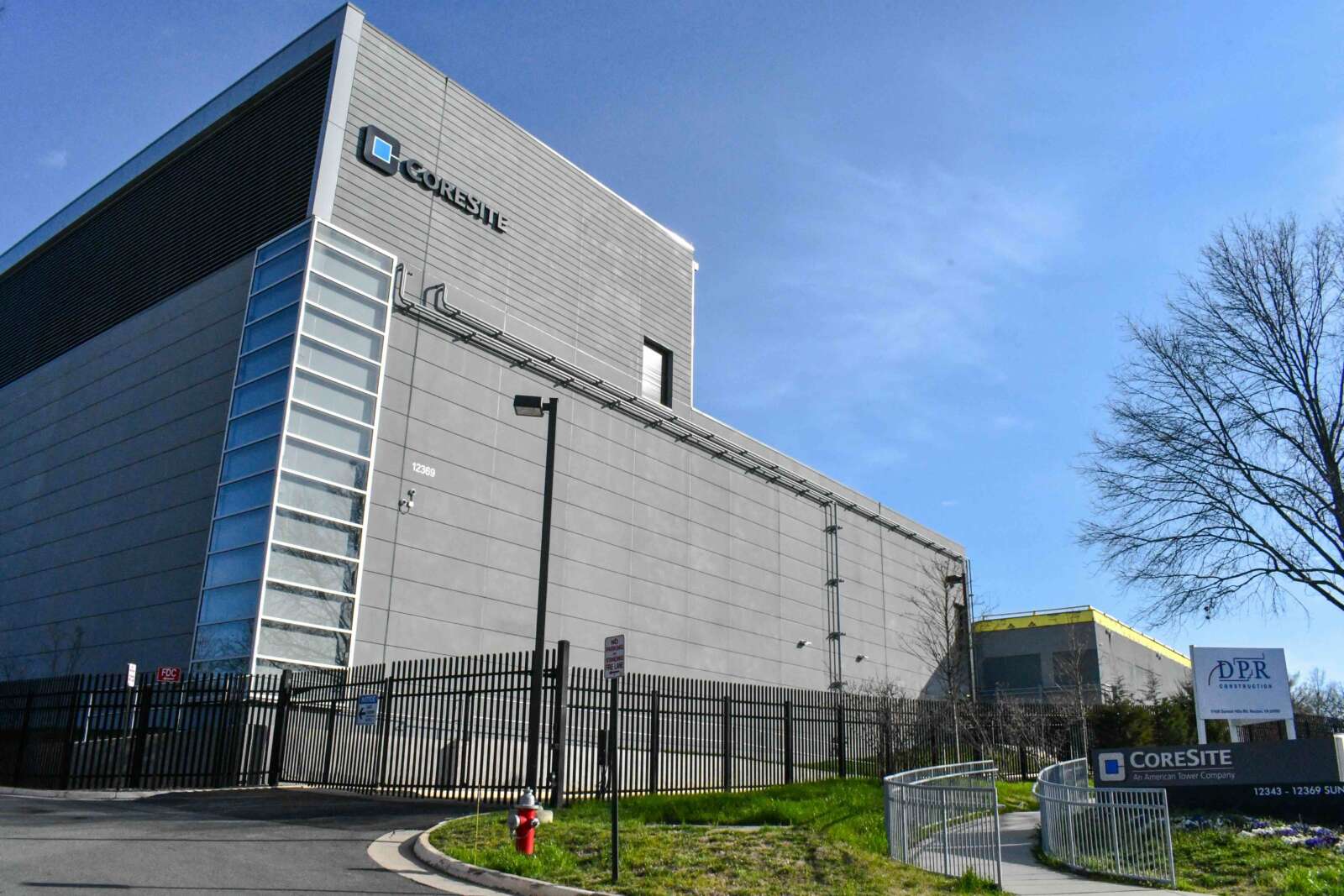
Amid a surge in digital storage demand in Northern Virginia, Fairfax County is drafting stricter zoning regulations to enhance oversight of data center projects.
On Tuesday (March 19), the Board of Supervisors directed staff to update the county’s zoning laws to include new data center development criteria, such as increased residential buffers, size limits, energy efficiency standards and a mandatory noise study in the site plan.
“The increasing demand for data centers and the increased understanding of their potential impacts reveal a need to consider strengthening our current regulations,” Sully District Supervisor Kathy Smith said, emphasizing the “urgency” of the new rules sought by the board.
Potential changes include new requirements for data center developments to receive a special exception in zoned areas where they are currently allowed by right, meaning they can be built without county board or planning commission approval or public hearings.
Last year, the board requested research, findings and recommendations from county staff on possible new guidelines for data centers, including ways to mitigate their environmental impact, criteria for locating facilities and the approval process for data centers.
The report presented to the board in January found that, while data centers bring advantages such as high-paying jobs and significant tax revenue, they have also encountered resistance from residents worried about the noise, greenhouse gas emissions, and high energy usage of the facilities.
At a land use policy committee meeting on March 12, the county supervisors signaled that they support staff’s recommendations for amending the zoning ordinance with higher standards.
Northern Virginia remains the world’s leader in data centers with 51 million square feet of space, per a recent JLL report. Fairfax County has roughly a third of the square footage of neighboring Loudoun and Prince William counties, the region’s epicenter of development.
Supervisors noted that there’s been significant community pushback against large projects like the recently approved Digital Gateway in Prince William. At Tuesday’s board meeting, Mason District Supervisor Andres Jimenez said the county needs to make sure “we’re putting data centers where they belong.”
“We have very few [data center projects] on the horizon that we know of, but it’s important that we get the protections right and the guidelines right, and the quickest way to do that is to get these zoning ordinance amendments approved,” Chairman Jeff McKay said.
The county staff recommendations
In terms of land use and site design, staff suggested that developers secure special exception approval from the county before constructing data centers in most commercial and industrial districts.
Staff also recommended that, in industrial districts where data centers are permitted by right, the county could proactively implement height and size limitations, along with minimum distances for equipment, such as generators, from residential zones.
Due to the swift pace of data center development, staff also advise collaborating with utility providers, including NOVEC and Dominion Energy, to evaluate how future development might affect energy demand. Read More

